
Cookers which concentrate light from above
In this type of solar cooker the light is concentrated from above. Though for cooking this mode of concentration of energy from the top is not very desirable there are several old designs which have used the method.
Water lens
Type LCA 1 (Figure 31) is an old idea which has been tried successfully in metallurgy. Antonine Lavosier (1743 – 1794) had used an alcohol lens to melt Platinum (MP 17600 C). The lens was made of two curved glass sheets joined to form a bi-convex lens and the space was filled with alcohol. The lens measured 130 cm in diameter and as its refractive power was rather insufficient to form a sharp focus, an additional lens of smaller diameter was used (Meinel, Meinel 1977).

Source:- TIDE., March 1998, 8-1, pp 1-37, For Comments, suggestions,contributions contact < ashok_kundapur@yahoo.com>
Salaria, Singh (1978) also advocated this idea for cooking, but felt that there was too much heat coming from the top so they advocated the use of a deflector to direct the focus to the bottom of the vessel (Figure 32). Instead of one large lens, several designers have proposed the use of a dome of multiple lenses, but De Witt C Maine was probably the first to apply for a patent (US Patent No. 4 057 048 of 12 November 1975) (Figure 33). Here again the heat coming from the top, that is focused sunlight, would be too much and it would be essential to divert the focus. Besides, it may be difficult to fabricate an assembly of lenses to have a long focal length. Of late, a multiple lens dome has been tried successfully in the case of power generation.

To offset some of the problems associated with such multiple lenses, the use of transparent Fresnel lenses was suggested (Mathur, Bansal 1981). The IIT, Delhi group was working on various aspects of large Fresnel lenses. Two configurations were recommended. In one, the vessel moves and in another the position of the lens is altered. If the cost of the Fresnel lens is low then these designs may become popular. There would still be the problem of durability; plastic lenses would blur very soon. Recently, Fatangare (1992) has also recommended these types of Fresnel lenses.
Concept V (Type LCA 3a) proposed in this compilation by the author suggests the use of a suitable large water lens incorporated in the roof, and the focus diverted to the base of the vessel. Provision has to be made to prevent the glare and also to cover the lens when it is not used (Figure 34).

Source:- TIDE., March 1998, 8-1, pp 1-37, For Comments, suggestions,contributions contact < ashok_kundapur@yahoo.com>
The cheapest solar cooker in this category was designed by VITA (1961). The reflector was made of disposable cardboard cones covered on the inside with reflective material (LCA 4, Figure 35). The three cones concentrated the light on to the top of the cooking vessel. The cones telescoped into one another for easy packing. VITA claimed that it could be used for warming the food or cooking some dry food.
Prof. Mann (1981) has improved on this design. He used only two cones, but with better reflection and concentrating characteristics (Type LCA 4a, Figure 36). The light was focused on tot he vessel kept in an insulated circular box underneath. This design could be a good alternative to the Telkes type of oven. Recently, El-Sebail (1994) too has proposed a similar design (LCA 4b)
Type LCA 5 (Figure 37) was an interesting model which appeared in Popular Science 219 (6): P. 84, 1981. Here, the cooking vessel was placed on a small platform covered with a glass jar, and two row of plane mirror assembly projected above this platform, so that the light came from the top (Anon. 198l b).
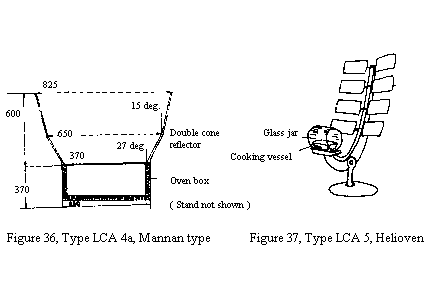
Recently, another very interesting but very simple design, and naturally very low cost design of solar cooker has been presented by a Bernard et al. (1995). Brand named ‘Cookit’ (Type LCA 6, Figure 38), it is just a packet of interconnected reflectors. When open, they fold out into a small bracket of reflectors around a cooking vessel kept in a transparent container or a heat resistant plastic. The cooker, probably the simplest among the lot, cheaper than that of VITA design, should work well in tropics.
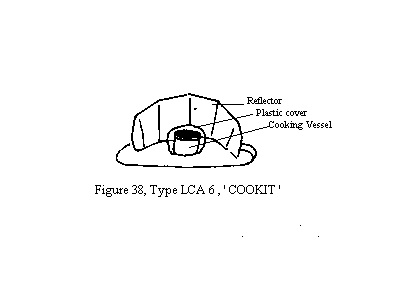
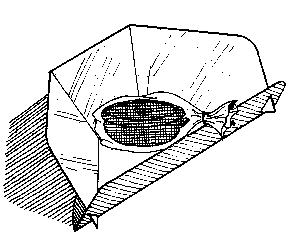
Fig.38a, 'COOKIT' as it appears in SCI site.
Popularity of this design has compelled me to include more details regarding the same. Prof. Bernard the the desiner of this unque and most simple design has brough out a bookk in French where he has presented many more simple designs. The Cookit is cut out from a cardboard of about 1 x 1 meter.Other material also can be used, for example Polished Aluminium or Stain less steel. After cutting the cardboard as directed aluminised Mylar or aluminium foil is sruck to it and fold it as shown and prop-it-up, and lo you have the cooker ready.
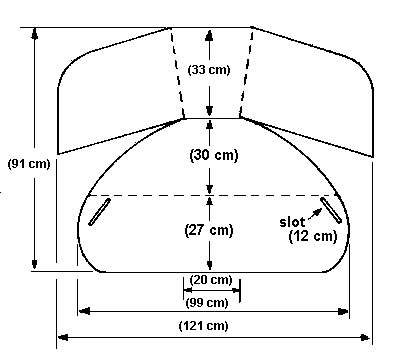
Fig. 38b, design details as in SCI site.
'COOKIT' seems to have become very popular especially after the introduction of the transperent bag around the cooking pot as suggested by Mrs. Barbera Kerr. Prof. Bernard himself had suggested use of a inverted transperent bowl around the black cooking pot. Later considering severl problems associated with such a transperent cover around around cooking pot he had suggested use of upright transperent bowl of a size larger than the cooking pot and had also suggested several other modifications to easy cooking. David ( see under other links) also reccommends this and in addition has tried to improve this idea.
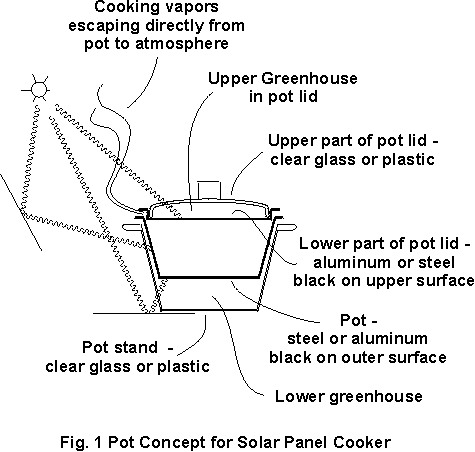
The diagram above gives a clear picture as to the assembly of black cooking pot in 'cookit'
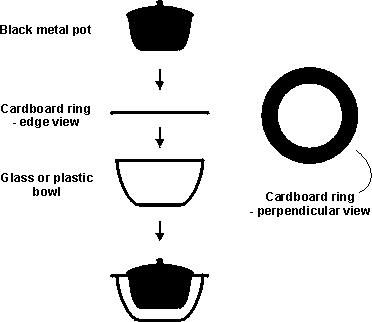
This diagram shows as to how a smaller pot could be held in a larger transperent upright glass bowl

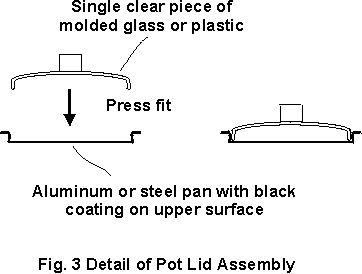
All the above diagrams are from David Delaneys site ( see under other links for URL )
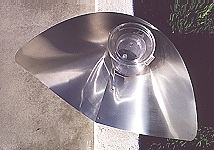
Deris has presented several similar cooking gadgets. Please visit her sites for further details ( under other links )
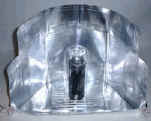
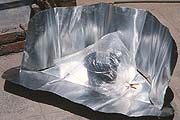


All the above illustrate different types of very simple cookers more or designs of which are very close to that of 'COOKIT'. Prof. Steven has another interesting variation which he calles a 'FUNNEL COOKER' and his following photo presents his innovation.
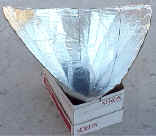
Most of such cookers would work very well, there are reports indicating that they have worked even in Nepal. But they all look rather small for me, but bigger reflectors should also work.
One of the most simple cookers could be that described by Deris Janette( URL under other links ), called as Cleardome Cooker it is just a semicircular row of plane mirrors around a cooking pot kept under two transperent domes.
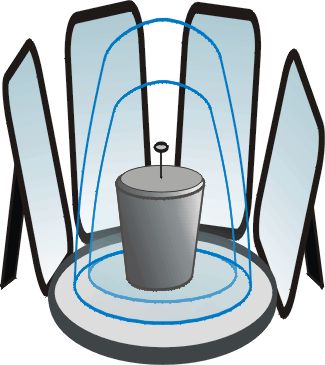
Deris's Clear dome solar cooker
As was indicated earlier, the cookers which concentrate the light from below stand a better chance in the field. The best candidate in the field is the Murthy type of asymmetrical reflector among the parabolic reflectors. In the cookers using plane mirror geometry the winner could be Prof. Bowman’s FIT design or Concepts III or IV proposed by the author in this review. Another proposal of the author, Concept V, which envisages the use of a large roof-top lens, could be ideal in smaller towns, with single-storied buildings, and, when the system is not used for cooking the concentrated heat could be used for heating water or to turn on a water pump or a generator.
Source:- TIDE., March 1998, 8-1, pp 1-37, For Comments, suggestions,contributions contact < ashok_kundapur@yahoo.com>
| PREVIOUS PARTParabolic Concentrators | NEXT PARTBox type designs |
||
For easy NAVIGATION use this chart.
OTHER LINKS are found under References S to W
click here for comments received
For Comments, suggestions,contributions contact < ashok_kundapur@yahoo.com>